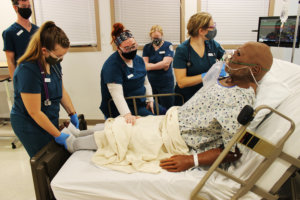SMCC’s health science simulation center has become more diverse with computerized manikins and other learning tools that reflect the diversity of real patients that students will care for upon entering the workforce.
The center, often called the “sim lab,” is used for hands-on training by students in SMCC’s health science programs. In the past couple of years, the lab has added dark-skinned manikins, while also using lifelike silicon masks that cover the manikin heads and provide realistic depictions of patients of different ages, genders and ethnicities.
Increasing diversity in the sim lab better prepares students for when they treat patients in real-world settings, Nursing Professor Martha Vrana-Bossart said on a recent day after her students performed an exercise on a dark-skinned simulation manikin in the lab. It also builds on SMCC’s commitment to build a respectful, welcoming and inclusive community that celebrates the College’s diversity.
“We have to be very conscious of ou r biases over race, gender, class and how people take care of themselves,” Vrana-Bossart said. “In terms of diversity and inclusion, it’s important to offer realistic patient presentations. With more diverse offerings in the sim lab, we are offering meaningful experiences for our students.”
r biases over race, gender, class and how people take care of themselves,” Vrana-Bossart said. “In terms of diversity and inclusion, it’s important to offer realistic patient presentations. With more diverse offerings in the sim lab, we are offering meaningful experiences for our students.”
The simulation center has realistic-looking lab rooms and computerized manikins that simulate real-life scenarios with real-life patients. The manikins can connect to a variety of monitors and provide information such as heart rate, blood pressure, oxygen levels and other vital signs. Operated from the sim lab’s control room, they can also bleed, cough, yell in pain and even ask questions just like real-life nursing patients.
Research has shown that there has been a lack of diversity in the manikins used in sim lab training facilities nationwide. However, the use of diverse training manikins has been increasing in recent years.
SMCC has been incorporating more diversity into its sim lab equipment — including simulation manikins and plastic arms and torsos used for various types of medical training — in recent years. The arms and torsos, known as “task trainers,” are used for a variety of training such as phlebotomy, intravenous lines and other medical administration techniques.
The sim lab plans to purchase more varieties of masks with the goal of being able to morph any standard manikin into a variety of patient types by gender, age, ethnicity and other characteristics.
Nate Taylor, a senior nursing student, said increased diversity makes students more aware of the wide variety of patients they will treat after becoming nurses. Healthcare providers, he said, must be prepared to treat patients of all backgrounds and provide culturally responsible care.
“This is absolutely a good thing,” he said after completing a training exercise on a dark-skinned manikin in the sim lab. “Anytime we can increase diversity in our training, it will increase our empathy for patients in the field who we might treat. It’s about giving the greatest level of care we can.”

